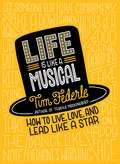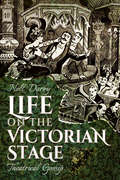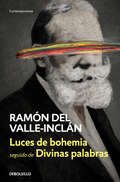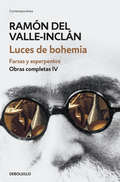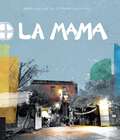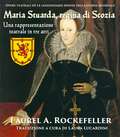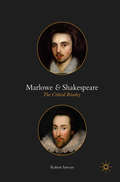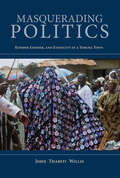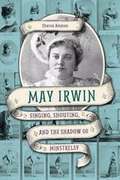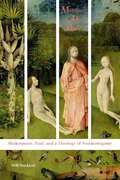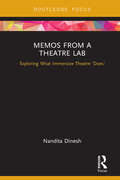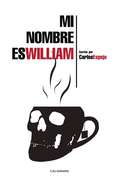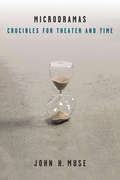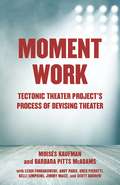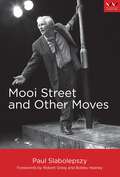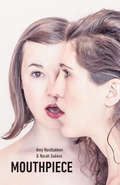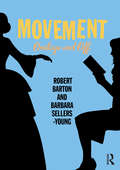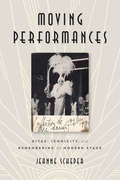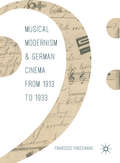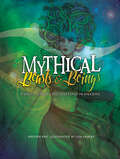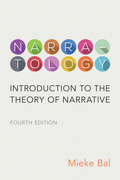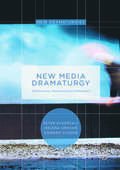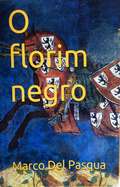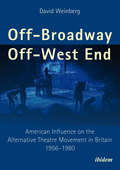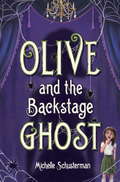- Table View
- List View
Life Is Like a Musical: How to Live, Love, and Lead Like a Star
by Tim FederleA Self-Help Guide--with Jazz Hands! Life is Like a Musical features 50 wry, witty tips on getting ahead in life and love--all learned in the showbiz trenches. "Hilarious, wise, and one-of-a-kind. This book is so damn brilliant I'm surprised it didn't already exist." -- Sarah Knight, bestselling author of The Life-Changing Magic of Not Giving a F*ck Before Tim Federle became a bestselling author and a Broadway playwright, he worked as a back-up dancer at the Super Bowl, a polar bear at Radio City, and a card-carrying chorus boy on Broadway. Life is Life a Musical features 50 tips learned backstage, onstage, and in between gigs, with chapters such as "Dance Like Everyone's Watching" and "Save the Drama for the Stage." This charming and clever guide will appeal to all ages and inspire readers to step into the lead role of their own life, even if they're not a recovering theater major.
Life on the Victorian Stage: Theatrical Gossip
by Nell DarbyThe expansion of the press in Victorian Britain meant more pages to be filled, and more stories to be found. Life on the Victorian Stage: Theatrical Gossip looks at how the everyday lives of Victorian performers and managers were used for such a purpose, with the British newspapers covering the good, the bad and the ugly side of life on the stage during the nineteenth century. Viewed through the prism of Victorian newspapers, and in particular through their gossip columns, this book looks at the perils facing actors from financial disasters or insecurity to stalking, from libel cases to criminal trials and offers an alternative view of the Victorian theatrical profession.This thoroughly researched and entertaining study looks at how the Victorian press covered the theatrical profession and, in particular, how it covered the misfortunes actors faced. It shows how the development of gossip columns and papers specializing in theater coverage enabled fans to gain an insight into their favorite performers lives that broke down the public-private divide of the stage and helped to create a very modern celebrity culture.The book looks at how technological developments enabled the press to expose the behavior of actors overseas, such as when actor Fred Solomon's' bigamy in America was revealed. It looks at the pressures facing actors, which could lead to suicide, and the impact of the 1857 Matrimonial Causes Act on what the newspapers covered, with theatrical divorce cases coming to form a significant part of their coverage in the latter half of the nineteenth century. Other major events, from theater disasters to the murder of actor William Terriss, are explored within the context of press reportage and its impact. The lives of those in the theatrical profession are put into their wider social context to explore how they lived, and how they were perceived by press and public in Victorian Britain.
Luces de bohemia | Divinas palabras
by Ramón del Valle-Inclán«Los más jóvenes no se han cansado de proclamar en los últimos años la estricta actualidad de Valle, y ven en los esperpentos la más segura vía de un teatro crítico.» Antonio Buero Vallejo Escritas con pocos meses de diferencia, en 1919 y 1920, después de una prolongada crisis creativa, las dos piezas reunidas en este volumen son unánimemente consideradas la cima del teatro de Valle-Inclán, lo que vale por decir que se cuentan entre las cumbres indiscutibles del teatro español (y europeo) del siglo XX, sobre el que han ejercido una persistente influencia. Por vías distintas -pues sus escenarios respectivos son la Galicia rural y el Madrid de la bohemia modernista-, las dos marcan un punto de inflexión en la trayectoria de su autor, que funda a partir de ellas una estética propia, el esperpento, con la que aspira a captar «el espíritu trágico de la vida española». Reseñas:«Valle-Inclán parece que escribió para nosotros y para quienes vengan después que nosotros, y es al mismo tiempo nuestro predecesor y nuestro contemporáneo.»Antonio Muñoz Molina «Una poderosa inyección vigorizante para la literatura en idioma castellano.»Juan Carlos Onetti «Valle-Inclán, el gran renovador del teatro español del siglo XX.»Ramón Irigoyen, El País
Luces de bohemia: Farsas y esperpentos (Obras completas Valle-Inclán #4)
by Ramón del Valle-InclánEl segundo volumen con la producción teatral de uno de los autores más destacados de la España contemporánea: Ramón María del Valle-Inclán. En su incesante exploración de una nueva teatralidad, Valle-Inclán emprende muy pronto un radical proceso de estilización dramática que cultiva el grotesco, la farsa, el metateatro y la deshumanización de los personajes. Títulos como Tablado de marionetas (1926), Retablo de la avaricia, la lujuria y la muerte (1927) y Martes de Carnaval (1930), en que recoge su producción de dos décadas, son expresivos de una tendencia que culmina en la formulación de una nueva y portentosa estética, el esperpento, cuyas premisas expone en la que es considerada por muchos su obra maestra: Luces de bohemia (1924). Reseña:«Alrededor de él vivía la vorágine del verbo, y lo mismo se le podía llamar demiurgo que taumaturgo.»Ramón Gómez de la Serna
Mama
by Adam CassIn August 2017, Melbourne's La Mama Theatre celebrates 50 years since the premiere of its first production, Jack Hibberd's 'Three Old Friends'. La Mama commemorates the rich life story of the theatre so far, tracking the history and chronology of the work that has been made and the many careers that have been born, raised and cherished there. Complemented by hundreds of wonderful photographs, the book is woven together through a series of rowdy yarns spun by the La Mama community, capturing a sense of the magic that has been inspiring audiences for fifty years.
Maria Stuarda, regina di Scozia: una rappresentazione teatrale in tre atti
by Laurel A. Rockefeller Laura LucardiniLa tragica storia della regina Maria Stuarda diventa un'opera teatrale in questa coinvolgente tragedia che ne racconta la vita, gli amori e il regno. Un'opera perfetta per le scuole e le compagnie amatoriali. Include bibliografia e cronologia degli eventi. Durata: 60-80 minuti.
Marlowe and Shakespeare
by Robert SawyerInstead of asserting any alleged rivalry between Marlowe and Shakespeare, Sawyer examines the literary reception of the two when the writers are placed in tandem during critical discourse or artistic production. Focusing on specific examples from the last 400 years, the study begins with Robert Greene's comments in 1592 and ends with the post-9/11 and 7/7 era. The study not only looks at literary critics and their assessments, but also at playwrights such as Aphra Behn, novelists such as Anthony Burgess, and late twentieth-century movie and theatre directors. The work concludes by showing how the most recent outbreak of Marlowe as Shakespeare's ghostwriter accelerates due to a climate of conspiracy, including "belief echoes," which presently permeate our cultural and critical discourse.
Masquerading Politics: Kinship, Gender, and Ethnicity in a Yoruba Town
by John Thabiti WillisIn West Africa, especially among Yoruba people, masquerades have the power to kill enemies, appoint kings, and grant fertility. John Thabiti Willis takes a close look at masquerade traditions in the Yoruba town of Otta, exploring transformations in performers, performances, and the institutional structures in which masquerade was used to reveal ongoing changes in notions of gender, kinship, and ethnic identity. As Willis focuses on performers and spectators, he reveals a history of masquerade that is rich and complex. His research offers a more nuanced understanding of performance practices in Africa and their role in forging alliances, consolidating state power, incorporating immigrants, executing criminals, and projecting individual and group power on both sides of the Afro-Atlantic world.
May Irwin: Singing, Shouting, and the Shadow of Minstrelsy
by Sharon AmmenMay Irwin reigned as America's queen of comedy and song from the 1880s through the 1920s. A genuine pop culture phenomenon, Irwin conquered the legitimate stage, composed song lyrics, and parlayed her celebrity into success as a cookbook author, suffragette, and real estate mogul. Sharon Ammen's in-depth study traces Irwin's hurly-burly life. Irwin gained fame when, layering aspects of minstrelsy over ragtime, she popularized a racist "Negro song" genre. Ammen examines this forgotten music, the society it both reflected and entertained, and the ways white and black audiences received Irwin's performances. She also delves into Irwin's hands-on management of her image and career, revealing how Irwin carefully built a public persona as a nurturing housewife whose maternal skills and performing acumen reinforced one another. Irwin's act, soaked in racist song and humor, built a fortune she never relinquished. Yet her career's legacy led to a posthumous obscurity as the nation that once adored her evolved and changed.
Members of His Body: Shakespeare, Paul, and a Theology of Nonmonogamy
by Will StocktonBuilding on scholarship regarding both biblical and early modern sexualities, Members of His Body protests the Christian defense of marital monogamy. According to the Paul who authors 1 Corinthians, believers would do well to remain single and focus instead on the messiah’s return. According to the Paul who authors Ephesians, plural marriage is the telos of Christian community. Turning to Shakespeare, Will Stockton shows how marriage functions in The Comedy of Errors, The Merchant of Venice, Othello, and The Winter’s Tale as a contested vehicle of Christian embodiment. Juxtaposing the marital theologies of the different Pauls and their later interpreters, Stockton reveals how these plays explore the racial, religious, and gender criteria for marital membership in the body of Christ. These plays further suggest that marital jealousy and paranoia about adultery result in part from a Christian theology of shared embodiment: the communion of believers in Christ.In the wake of recent arguments that expanding marriage rights to gay people will open the door to the cultural acceptance and legalization of plural marriage, Members of His Body reminds us that much Christian theology already looks forward to this end.
Memos from a Theatre Lab: Exploring what immersive theatre 'does' (Series In Performing Arts Ser.)
by Nandita DineshWhat does Immersive Theatre ‘do’? By contrasting two specific performances on the same theme – one an ‘immersive’ experience and the other a more conventional theatrical production – Nandita Dinesh explores the ways in which theatrical form impacts upon actors and audiences. An in-depth case study of her work Pinjare (Cages) sets out the ‘hows’ and ‘whys’ of her specific aesthetic framework. Memos from a Theatre Lab places Dinesh’s practical work within the context of existing analyses of Immersive Theatre, using this investigation to generate an underpinning theory of how Immersive Theatre works for its participants.
Mi nombre es William
by Carlos Espejo¿Qué pasaría si el dramaturgo más famoso de todos los tiempos se quedara sin imaginación? <P><P>En un Londres actual, un joven dramaturgo frustrado por su trabajo, llamado William Shakespeare, entra en su pequeño estudio. No tiene ni con qué comer, la inspiración parece que le ha abandonado desde hacía mucho tiempo. Su editor le pide el manuscrito de su obra La venganza de las familias y tiene menos de cuarenta y ocho horas para terminarlo. William les ruega desesperadamente, sin esperanza, ayuda a las musas del teatro. Su llamada recibe respuesta... <P>Esa será la última noche que dormirá plácidamente nuestro protagonista.
Microdramas: Crucibles for Theater and Time
by John H. MuseIn Microdramas, John H. Muse argues that plays shorter than twenty minutes deserve sustained attention, and that brevity should be considered a distinct mode of theatrical practice. Focusing on artists for whom brevity became both a structural principle and a tool to investigate theater itself (August Strindberg, Maurice Maeterlinck, F. T. Marinetti, Samuel Beckett, Suzan-Lori Parks, and Caryl Churchill), the book explores four episodes in the history of very short theater, all characterized by the self-conscious embrace of brevity. The story moves from the birth of the modernist microdrama in French little theaters in the 1880s, to the explicit worship of speed in Italian Futurist synthetic theater, to Samuel Beckett’s often-misunderstood short plays, and finally to a range of contemporary playwrights whose long compilations of shorts offer a new take on momentary theater. Subjecting short plays to extended scrutiny upends assumptions about brief or minimal art, and about theatrical experience. The book shows that short performances often demand greater attention from audiences than plays that unfold more predictably. Microdramas put pressure on preconceptions about which aspects of theater might be fundamental and about what might qualify as an event. In the process, they suggest answers to crucial questions about time, spectatorship, and significance.
Moment Work: Tectonic Theater Project's Process of Devising Theater
by Moises Kaufman Barbara Pitts McAdamsA detailed guide to the collaborative method developed by the acclaimed creators of The Laramie Project and Gross Indecency--destined to become a classic. A Vintage Original.By Moisés Kaufman and Barbara Pitts McAdams with Leigh Fondakowski, Andy Paris, Greg Pierotti, Kelli Simpkins, Jimmy Maize, and Scott Barrow. For more than two decades, the members of Tectonic Theater Project have been rigorously experimenting with the process of theatrical creation. Here they set forth a detailed manual of their devising method and a thorough chronicle of how they wrote some of their best-known works. This book is for all theater artists—actors, writers, designers, and directors—who wish to create work that embraces the unbridled potential of the stage.
Mooi Street and Other Moves
by Paul SlabolepszyA collection of six plays by South Africa’s leading playwright and actor featuring works written between 1984 and 1993.
Mouthpiece
by Norah Sadava Norah Sadava Amy NostbakkenWinner of the 2017 Toronto Theatre Critics Award for Best New Canadian PlayWinner of three Dora Mavor Moore AwardsStage Award for Best Performance, 2017 Edinburgh Festival FringeMouthpiece follows one woman, for one day, as she tries to find her voice. Two performers express the inner conflict that exists within a modern woman's head: the push and pull, the past and the present, the progress and the regression. Interweaving a cappella harmony, dissonance, text, and physicality, Mouthpiece is a harrowing, humorous, and heart-wrenching journey into the female psyche.
Movement: Onstage and Off
by Robert Barton Barbara Sellers-YoungMovement: Onstage and Off is the complete guide for actors to the most effective techniques for developing a fully expressive body. It is a comprehensive compilation of established fundamentals, a handbook for movement centered personal growth and a guide to helping actors and teachers make informed decisions for advanced study. This book includes: fundamental healing/conditioning processes essential techniques required for versatile performance specialized skills various training approaches and ways to frame the actor’s movement training. Using imitation exercises to sharpen awareness, accessible language and adaptable material for solo and group work, the authors aim to empower actors of all levels to unleash their extraordinary potential.
Moving Performances: Divas, Iconicity, and Remembering the Modern Stage
by Jeanne ScheperFabulous yet fierce, imperious yet impetuous, boss yet bitchy—divas are figures of paradox. Their place in culture is equally contradictory, as they are simultaneously venerated and marginalized, hailed as timeless but then frequently forgotten or exhumed as cult icons by future generations. Focusing on four early twentieth-century divas—Aida Overton Walker, Loïe Fuller, Libby Holman, and Josephine Baker—who were icons in their own time, Moving Performances considers what their past and current reception reveals about changing ideas of race and gender. Jeanne Scheper examines how iconicity can actually work to the diva’s detriment, reducing her to a fetish object, a grotesque, or a figure of nostalgia. Yet she also locates more productive modes of reception that reach to revive the diva’s moving performances, imbuing her with an affective afterlife. As it offers innovative theorizations of performance, reception, and affect, Moving Performances also introduces readers to four remarkable women who worked as both cultural producers and critics, deftly subverting the tropes of exoticism, orientalism, and primitivism commonly used to dismiss women of color. Rejecting iconic depictions of these divas as frozen in a past moment, Scheper vividly demonstrates how their performances continue to inspire ongoing movements.
Musical Modernism and German Cinema from 1913 to 1933
by Francesco FinocchiaroThis book investigates the relationship between musical Modernism and German cinema. It paves the way for anunorthodox path of research, one which has been little explored up until now. The main figures of musical Modernism, from Alban Berg to Paul Hindemith, and from Richard Strauss to Kurt Weill, actually had a significant relationship with cinema. True, it was a complex and contradictory relationship in which cinema often emerged more as an aesthetic point of reference than an objective reality; nonetheless, the reception of the language and aesthetic of cinema had significant influence on the domain of music. Between 1913 and 1933, Modernist composers' exploration of cinema reached such a degree of pervasiveness and consistency as to become a true aesthetic paradigm, a paradigm that sat at the very heart of the Modernist project. In this insightful volume, Finocchiaro shows that the creative confrontation with the avant-garde medium par excellence can be regarded as a vector of musical Modernism: a new aesthetic paradigm for the very process - of deliberate misinterpretation, creative revisionism, and sometimes even intentional subversion of the Classic-Romantic tradition - which realized the "dream of Otherness" of the Modernist generation.
Mythical Beasts & Beings: A Visual Guide to the Creatures of Folklore (Xist Children's Books)
by Lisa GravesA Mythical Creatures Guide with Stunning Illustrations Lisa Graves takes on monsters, fairies, gods and dragons in this illustrated guide to mythological creatures. Featuring legends from around the world, this collection provides information for fans of mythology, magic and more in a lovely volume.
Narratology: Introduction to the Theory of Narrative, Fourth Edition
by Mieke BalSince its first publication in English in 1985, Mieke Bal's Narratology has become an international classic and the comprehensive introduction to the theory of narrative texts, both literary and non-literary. Providing insights into how readers interpret narrative text, the fourth edition of Narratology is a guide for students and scholars seeking to analyze narratives of any language, period, and region with clear, systematic and reliable concepts. With the addition of in-depth analysis of literary nuances and methods, award-wining cultural theorist Mieke Bal continues to present narrative concepts with clarity. Bal uses a systematic framework to better explain how narratives function, are formed, and eventually interpreted by the reader, while presenting a comprehensive study of the surface perception of language, the perceived narrative world, point of view, and characterization.
New Media Dramaturgy
by Peter Eckersall Helena Grehan Edward ScheerThis book illuminates the shift in approaches to the uses of theatre and performance technology in the past twenty-five years and develops an account of new media dramaturgy (NMD), an approach to theatre informed by what the technology itself seems to want to say. Born of the synthesis of new media and new dramaturgy, NMD is practiced and performed in the work of a range of important artists from dumb type and their 1989 analog-industrial machine performance pH, to more recent examples from the work of Kris Verdonck and his A Two Dogs Company. Engaging with works from a range of artists and companies including: Blast Theory, Olafur Eliasson, Nakaya Fujiko and Janet Cardiff, we see a range of extruded performative technologies operating overtly on, with and against human bodies alongside more subtle dispersed, interactive and experiential media.
O Florim Negro
by Sandra Santos Marco Del PasquaUmberto é um médico milanês, agora, prestes a se aposentar. Por pura curiosidade, investiga sobre a origem do seu sobrenome e descobre uma distante origem nobre toscana. O seu ancestral gibelino se refugiou em 1285 em um castelo em Siena com o bispo de Arezzo. Guglielmo, da família nobre Ubertini, instigou uma rebelião contra a cidade de Siena, que terminara meses depois, com um banho de sangue.O protagonista, fascinado pelas belezas do lugar, decide comprar uma casa nas vizinhanças do castelo, abandonado e inacessível por anos. Deixa Milão para se mudar e passar a velhice. Durante os trabalhos de restauração encontra, ao acaso, uma moeda antiga fiorentina, um florim de cobre, também chamado de florim negro, e Cesira, uma clarividente, percebeu que a moeda pertencia a um personagem muito importante: Dante Alighieri, e fora perdida em circunstâncias tumultuadas e dramáticas.O romance narra a história de Riccardo, um soldado de infantaria fiorentino, que ficara ao lado do jovem cavaleiro Dante Alighieri durante o terrível cerco ao castelo. A história do jovem Riccardo, no século XIII, se cruza com a de Umberto até os dias de hoje, para ambos, os eventos que acontecem naquele castelo mudarão a vida para sempre.Umberto, como Riccardo séculos antes, descobrirá o amor naquele mesmo lugar.Dois protagonistas de épocas diferentes, um paralelo entre eles, que desafiam o desconhecido, descobrindo novas e inesperadas paixões. Uma história aventurosa de homens, armas e amor, que se entrelaça entre a Idade Média e os dias atuais.
Off-Broadway/Off-West End: American Influence on the Alternative Theatre Movement in Britain 1956–1980
by David WeinbergDavid Weinberg argues that American experimental theater practice was a key factor in the development of the alternative theater movement in Britain during the period 1956–1980. He covers the activities of the experimental theater groups associated with Jim Haynes, Charles Marowitz, Nancy Meckler, and Ed Berman, four expatriate American theater practitioners living in Britain. In addition, he also examines important American-based groups—Living Theatre (1947), Open Theatre (1964), La MaMa (1960), and Bread and Puppet (1965)—which performed in Britain and which made an impact during the same period, as well as a wide range of indigenous British groups—Pip Simmons (1968), Foco Novo (1972–1989), Joint Stock (1974–1989), institutions—RSC (1961), Royal Court (1956)—and individuals such as Max Stafford-Clark, Thelma Holt, John Arden, Ann Jellicoe, and the Portable playwrights (1968–1972), which in one way or another were influenced by American exemplars. Weinberg's study is essential reading for everyone seeking a more comprehensive and dynamic understanding of the forces which shaped the alternative theatrer movement in Britain.
Olive and the Backstage Ghost
by Michelle SchustermanA ghost story with a literary heart for fans of Neil Gaiman’s Coraline and The Graveyard Book. Theater kids and ghost-story readers alike will find new meaning in the term stage fright. All great theaters have their ghosts. . . . After Olive Preiss freezes during a theater camp audition, she flees in despair. She finds herself at Maudeville, a beautiful old theater that she’s never noticed before. She enters, goes onstage, and sings her song. “Thank you for that lovely audition, darling,” comes a voice from the shadows. “I believe I have just the part for you.” Olive is thrilled to work with Maude Devore, the glamorous actress who owns the theater, and her eclectic cast of misfits. Yet gradually there are signs that Maudeville isn’t exactly what it seems. Sometimes—just for a moment!—it feels wrong. As opening day approaches, Olive’s doubts and fears grow. But no matter what, this show must go on . . . and on . . . and on. . . . “Equal parts heart and bone-deep creepiness.” —Claire Legrand, author of The Cavendish Home for Boys and Girls
